Table of Contents[Hide][Show]
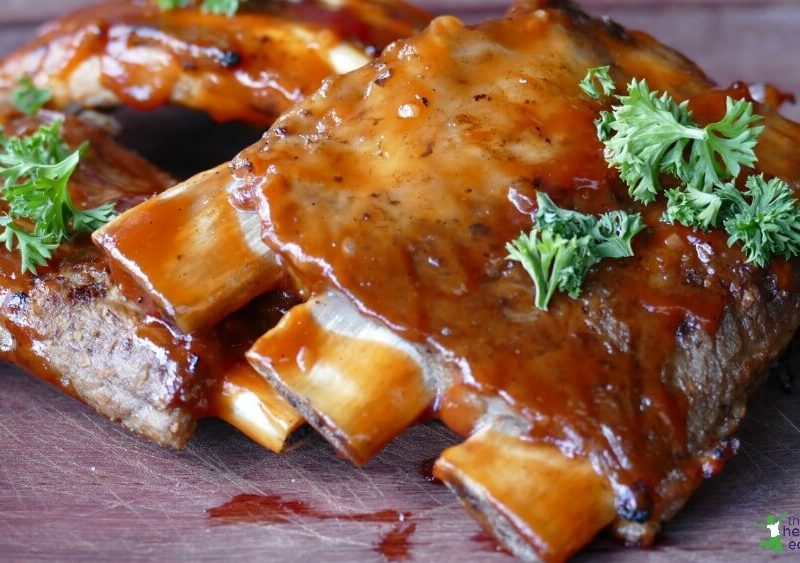
I don’t order ribs at restaurants because the sauce invariably contains high fructose corn syrup. This totally toxic genetically modified sweetener, even in small amounts, gives me a canker sore (or a zit) in a hurry. Sometimes within the hour if I get enough of it.
Our whole family loves ribs, though, especially pastured pork ribs.
So what to do?
The solution to avoid the nasty restaurant sauces is to make ribs yourself with a homemade sauce that is just as enjoyable without any downside!
Bonus, you can lick your fingers at home without any judgment!
Do Pork Ribs Need to be Marinated?
One question I know I will get about this recipe is why aren’t the ribs marinated?
Marinating is, after all, one of the primary ways traditional cultures prepared pork before eating to ensure its safety.
The answer is that slow cooking performs a similar function. The ribs below are boiled first and then roasted at a low temperature for up to 3 hours. This ensures a complete and thorough slow cook.
This is a common practice in the long-lived Okinawan culture, where they slowly stewed their pork before eating.
The most important time to marinate pork is when it will be quickly cooked, as in making pork chops and the like.
If you don’t eat pork for whatever reason, feel free to substitute beef short ribs instead.
Where to Find Pastured Pork Ribs
I buy grassfed pork ribs from two places.
My first choice, is to buy pork ribs from local farms in my area. If you live in Central Florida, I recommend Trailbale Farm, which will have pork cuts on its website in the coming weeks. This family farm’s products are delivered free (with a reasonable minimum order) and also featured at numerous farmers markets.
In addition, Whole Foods gets really good ribs from time to time. Keep on the lookout if you shop there occasionally.
If you live in a food desert, your only option short of raising a pig yourself is to order pastured pork ribs online and have them shipped to your door.
Be sure to make pork broth with the rib bones after you’ve finished enjoying this recipe!
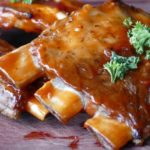
Pork Ribs Recipe (melt in your mouth!)
Traditional recipe for pork ribs that are melt in your mouth and covered in a sauce that is just as sweet and tasty as restaurants, but without all the nasty ingredients.
Ingredients
- 2-4 pounds pork ribs 10-20 ribs, preferably pastured
- 2-4 cloves garlic crushed
- filtered water
- 1 tsp sea salt
Sauce
- 1 cup ketchup
- 1/2 cup brown sugar
- 1/2 cup date syrup
- 1/4 cup brown mustard
- 2 tablespoons worcestershire sauce
- 1-2 tsp smoked paprika powder
Equipment
- 1-2 cedar wrap paper instead of foil or liquid smoke
Instructions
-
Simmer ribs for 30 minutes in a pot with enough water to cover along with sea salt and garlic cloves.
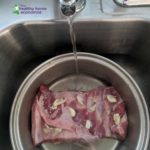
-
While ribs are simmering, make the sauce in a small saucepan on the stovetop on low heat to ensure all the ingredients blend well.
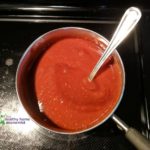
-
Remove ribs from pot, pat dry with a clean dishtowel, and place in roasting pan. Pour the sauce over the ribs and cover with sustainably produced cedar wrap paper. You can use foil too, but cedar wrap paper will do the same job and impart a delightful smoky flavor without the use of aluminum!
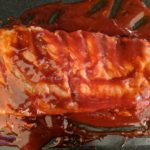
-
Bake at 225 F/107 C for 3-4 hours. Remove from oven and serve immediately.

Recipe Notes
Be sure to only use organic brown sugar as conventional brown sugar from the supermarket is all or partially GMO (unless it is specifically labeled "brown cane sugar").
Substitute sustainably produced coconut sugar for the brown sugar if desired.
This recipe makes a lot of sauce, so select the amount of ribs you cook (2-4 pounds) depending on whether you like the ribs drenched in sauce or only just covered.








Can these be made without simmering and just cooked at low temp?
For best results, follow the recipe as detailed. I don’t think it will turn out as well otherwise.
These turned out really well. I would actually rate this more like a 4.5. Almost perfect, but not quite there. I usually just put ribs in a glass baking dish and slow cook with home made BBQ in the oven. But then about a year ago the farmer we buy them from told me about just putting them in the slow cooker. Both methods yielded moist, falling apart ribs. But they were falling apart to the point that they were kind of no fun to eat because they weren’t even on the bones at that point. This method yielded meat that maintained it’s shape and stayed on the bones, however, the meat was pretty dry. I would definitely use this method again, but would probably add some water to the bottom of the pan to “steam” the ribs a little and try to better maintain some moisture. I think with boiling the ribs first, juices from the meat AND a lot of the fat got simmered out.
I found your article on the effects of eating fresh pork – and the blood concerns – so interesting. It will influence my future pork consumption! And that article led me to this one. I am wondering if you use ketchup without hfcs – most of it comes with that. I have problems with the virus also and know what you mean. I avoid corn like the ‘plague’! Thanks for your sharings.
I’ve never, ever heard this before, and I’m grateful to have found your blog!
I have been cooking my ribs in the Instant Pot before moving them to the oven. I can’t imagine this practice needs to be changed, but let me know if you have any input. I’m also grateful you mentioned the coconut sugar and can I use honey? Jovial uses honey in a lot of their recipes but I think I saw on your blog somewhere that it’s a bad idea to cook it. I came to your blog by way of your soaked einkorn bread machine recipe.
I’ve purchased diced canned tomatoes and olive oil from Jovial and was really pleased with the outstanding flavor and reasonable prices so I’m purchasing the 25 lbs. of einkorn.
Thanks for your help.
It’s not a good idea to cook with honey. It destroys its properties and Ayurvedic medicine teaches that cooked honey contributes to the development of disease.
Hi Sarah,
Can the water from boiling the ribs be utilized for any useful purpose or would it contain toxins or other detrimental qualities?
The water would be fine to use as a base for a soup or sauce.